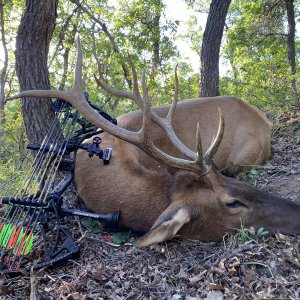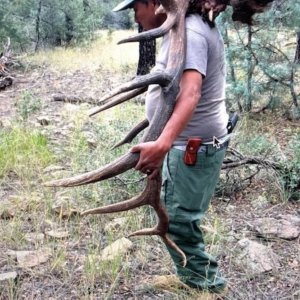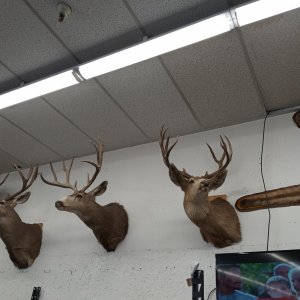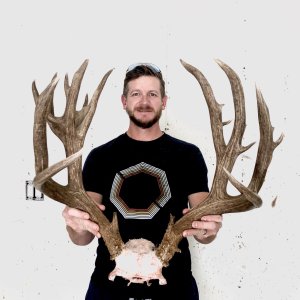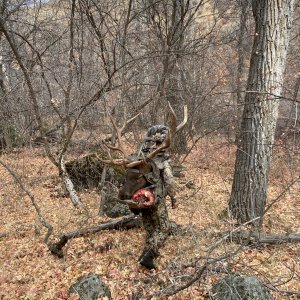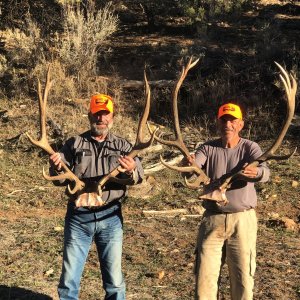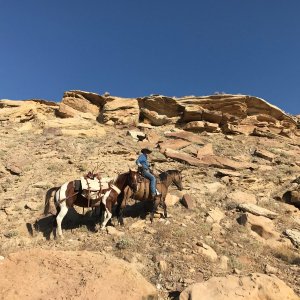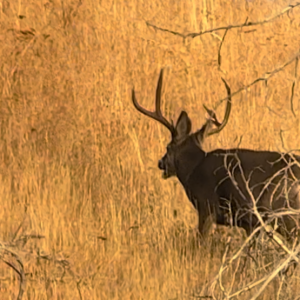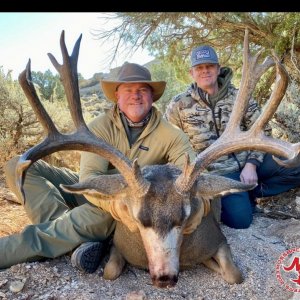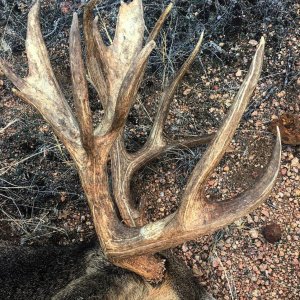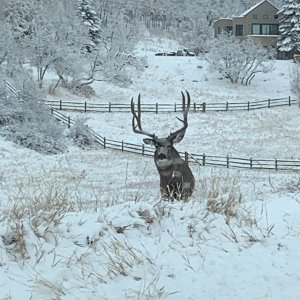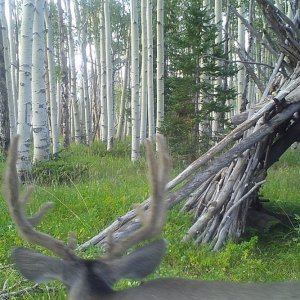P
pinenut
Guest
I took some time tonight to write some thoughts about the great question posed by the "Old Man". It got really long but I strongly believe in what I wrote, so I wanted to create an original post so more people would view it.
Thank you old man of the hills for asking your question.
There is no doubt in my mind that we are "screwing ourselves" by selecting to harvest the bucks with the biggest antlers.
Before I talk about genetics, let me say that I fully understand the factor that age has to play, a very small percentage of bucks at 3 years of age will grow as large of antlers as the average 6 year old. I fully agree with the other writers about how we would all be surprised if we didn't hunt a herd for 5 or 6 years what type of bucks would be produced. I believe our deer herds are way too overhunted and it is too many permits combined with far too much access and killing technology that has led to the sad state that most deer hunting has become. If management strategies were put in place to allow for many 3 year olds up to some 6-7 year old deer, there would simply be more nice looking bucks around. It is lack of older bucks that is the biggest problem in most deer units, but we are slowly but surely also diminishing the genetics in these herds.
The way i see it, genetics are like slots of a roulette wheel. A buck that grows a huge rack likely has more slots on his genetic wheel that if landed on will produce another big buck. If this buck breeds a doe that also has a high percentage of slots with big buck genes, the offspring is more likely to grow big antlers. If a 6 year old 2x3 breeds a doe whose mom and dad both carried inferior antlered genes, the fawn is far more likely to grow lesser antlers. It is not a guarantee of course, just more likely. This is how genes and evolution work, yes there are exceptions, but over many generations the "superior" genes get passed on and the inferior genes get weeded out.
I don't think growing 16 inch G4's or a bunch of extra points has ever affected a bucks chance of being preyed upon (therefore removed from the breeding pool) until the last 50 years or so, and this pressure is being ramped up every year. I have no doubt that when you choose to shoot a 4 year old 7x5 that scores 190 instead of the 6 year old 3x4 that scores 160 you are forever causing a decrease in the genetic potential of that deer herd to grow big antlers. I think we are currently causing a rapid reverse evolution in our deer herds in terms of antler size by the way we choose which bucks to kill. Yes there will still be big non-typical bucks, but the percentage of fawns born with the genetic potential to grow this rack will continue to decline as we choose to kill the adults with this characteristic over ones that don't carry it. On all deer units across the country, from a survival point of view for bucks, it has become very, very beneficial to grow lesser antlers because of the hunting styles of man. Never before has a predator chosen to pick the biggest and most healthy (from an antler point of view) members of the prey population to kill. Never before has a predator had the ability to do this. We are indeed "screwing ourselves" forever in terms on the antler size potential of adult bucks.
I understand that a son (or daughter) of Popeye had the exact same likelihood of receiving the massive antler genes when Popeye fathered him as a 22 inch 4x4 when 2 years old, or during the four years he was a giant. However, "Popeye's" are far more likely to be killed as a 3 or 4 year old than a lesser buck. When the big 3 points get an extra year or two to pass on their genes, they will surely father more fawns, and their fawns are indeed more likely to grow up to be big 3's than Popeye's kids were. If a buck with the ability to grow a monster rack gets killed as a 4 year old after fathering 18 fawns his first 3 breeding seasons, whereas a buck without G3's because of genetics gets to live to 6 years in the same unit solely because of this genetic defect gets to father 34 fawns because he got to see 2 more breeding seasons as a massive bodied adult buck, the genetic pool is declined in that herd.
Genetics are not just being killed on the limited entry units, it happens on the extremely overhunted units as well. There are many units were a buck has a very small chance of reaching 4 years of age, eliminating the bigger antlered genes deer from ever growing their large racks. However, a buck with the potential to grow a B & C rack at 6 will likely grow a bigger rack as a two year old too. There are many hunters who would pass on a 2 year old 16 inch 2-point but shoot a 2 year old buck with a spread in the low 20's and 6 inch forks front and back. Every time that happens the genetic potential for the herd is cut back, forever.
That is how i view genetics to work. As we choose to remove the bucks with the biggest antlers over bucks with lesser, we are removing "likely" to grow buck antler genes. As more and more deer with a higher percentage chance to pass on these genes to their offspring are removed leaving more and more lesser bucks to do the breeding, more and more lesser bucks will be fathered. This has already happened, I am certain of that too. With all other factors being equal (weather, etc.) I am certain the average B&C score of all 6 year old bucks alive today in the West is less than it was 50 years ago, solely because we have been killing the best genetic deer at a more frequent pace than the others. Of course I have no data to prove this, but I strongly believe this to be the case.
I also strongly believe that the average antler size in mature bucks will continue to decline as we develop more and more means to find and remove the better antler genetics from the breeding pool. With every technology that allows us to get closer and closer to a situation where it is possible to view every buck in the herd equally and then allows us to kill the biggest, we forever ?screw ourselves?. By allowing hunters to access nearly every canyon in the West on ATV?s, we both reduce the average age class of bucks, but also cause the death of superior antlered bucks to become more likely. As aerial scouting gets more and more popular, this will further accelerate this trend.
As an example, think about what would happen if we were to kill the biggest bucks in a deer herd while every deer is equally vulnerable. Say the Wyoming Game & Fish gave out an unlimited number of tags valid for mule deer with at least 6 points on a side for the months of Nov-Jan. in a couple of counties in Western Wyoming for the next 20 years (where every deer in the herd is equally vulnerable to be viewed and killed in this example). Then, because of this, nearly every buck that came in with 6 points on a side was shot every year, do you really think that after 20 years there would be the same number of bucks with multi non-typical points as today? No way! and there never would be again. This is what is occurring on all units across the West, just on a slower (but over time as equally destructive) scale.
This is one of the reasons why I do not support the ridiculous amount of access by motorized vehicles we currently have in the West. Any tool that allows us to view many animals and kill the best is destructive. This is a huge reason why I do not support aerial scouting. This takes our ability as a predator to kill the biggest bucks to an unprecedented level, and further accelerates the demise of the genetic potential of the mule deer to grow the big antlers we are all after. I do not support selling hundreds of tags to people who then hire many guides to look at hundreds of bucks just to kill the best, this is harmful. Even the couple of early/late season tags that are given are extremely harmful to our herds. By viewing many and killing the best, we reduce the genetic potential of the next generation (a common theme in this article). For example, I have no doubt that there would be more bigger four points in Spanish Fork Canyon today if that buck killed in 2000 would have been able to breed one more year. How many 6 year old weak fork bucks are viewed each year in Utah that would get killed by the auction tag if they were instead a 260 inch buck? I would guess the number approaches a thousand. No I am not saying that in 10 years there will be no big bucks, but I am saying there will be less because of the issues discussed above.
One thing I can't figure out is how I feel about myself and the way I hunt. I have on several occasions passed on inferior antlered bucks to later remove superior antlered bucks from the gene pool. This was accomplished without an ATV or airplane, but I still did it nonetheless. I would like to think this method of hunting is not nearly as destructive as the guy flying a plane to locate the biggest deer in the unit and then killing it, but I am certain it does harm the herds at least some. I guess this is something further to think about.
I hope I am way off base and completely clueless with these thoughts, and that a fawn born in 2050 years after 10 generations of bucks have been subjected to $2000 spotting scopes, 1 ATV per hunter, extensive aerial scouting, 500+ yard rifles/scopes, etc., etc., etc. will be just as likely to be given the genetic potential to grow a 220 inch rack as a buck born in 1950, but I think there is no way that could be true. We are screwing ourselves, and this ?screwing of ourselves? will continue to accelerate, period.
Thanks for taking the time to read that, feel free to disagree.
-RPinenut
Thank you old man of the hills for asking your question.
There is no doubt in my mind that we are "screwing ourselves" by selecting to harvest the bucks with the biggest antlers.
Before I talk about genetics, let me say that I fully understand the factor that age has to play, a very small percentage of bucks at 3 years of age will grow as large of antlers as the average 6 year old. I fully agree with the other writers about how we would all be surprised if we didn't hunt a herd for 5 or 6 years what type of bucks would be produced. I believe our deer herds are way too overhunted and it is too many permits combined with far too much access and killing technology that has led to the sad state that most deer hunting has become. If management strategies were put in place to allow for many 3 year olds up to some 6-7 year old deer, there would simply be more nice looking bucks around. It is lack of older bucks that is the biggest problem in most deer units, but we are slowly but surely also diminishing the genetics in these herds.
The way i see it, genetics are like slots of a roulette wheel. A buck that grows a huge rack likely has more slots on his genetic wheel that if landed on will produce another big buck. If this buck breeds a doe that also has a high percentage of slots with big buck genes, the offspring is more likely to grow big antlers. If a 6 year old 2x3 breeds a doe whose mom and dad both carried inferior antlered genes, the fawn is far more likely to grow lesser antlers. It is not a guarantee of course, just more likely. This is how genes and evolution work, yes there are exceptions, but over many generations the "superior" genes get passed on and the inferior genes get weeded out.
I don't think growing 16 inch G4's or a bunch of extra points has ever affected a bucks chance of being preyed upon (therefore removed from the breeding pool) until the last 50 years or so, and this pressure is being ramped up every year. I have no doubt that when you choose to shoot a 4 year old 7x5 that scores 190 instead of the 6 year old 3x4 that scores 160 you are forever causing a decrease in the genetic potential of that deer herd to grow big antlers. I think we are currently causing a rapid reverse evolution in our deer herds in terms of antler size by the way we choose which bucks to kill. Yes there will still be big non-typical bucks, but the percentage of fawns born with the genetic potential to grow this rack will continue to decline as we choose to kill the adults with this characteristic over ones that don't carry it. On all deer units across the country, from a survival point of view for bucks, it has become very, very beneficial to grow lesser antlers because of the hunting styles of man. Never before has a predator chosen to pick the biggest and most healthy (from an antler point of view) members of the prey population to kill. Never before has a predator had the ability to do this. We are indeed "screwing ourselves" forever in terms on the antler size potential of adult bucks.
I understand that a son (or daughter) of Popeye had the exact same likelihood of receiving the massive antler genes when Popeye fathered him as a 22 inch 4x4 when 2 years old, or during the four years he was a giant. However, "Popeye's" are far more likely to be killed as a 3 or 4 year old than a lesser buck. When the big 3 points get an extra year or two to pass on their genes, they will surely father more fawns, and their fawns are indeed more likely to grow up to be big 3's than Popeye's kids were. If a buck with the ability to grow a monster rack gets killed as a 4 year old after fathering 18 fawns his first 3 breeding seasons, whereas a buck without G3's because of genetics gets to live to 6 years in the same unit solely because of this genetic defect gets to father 34 fawns because he got to see 2 more breeding seasons as a massive bodied adult buck, the genetic pool is declined in that herd.
Genetics are not just being killed on the limited entry units, it happens on the extremely overhunted units as well. There are many units were a buck has a very small chance of reaching 4 years of age, eliminating the bigger antlered genes deer from ever growing their large racks. However, a buck with the potential to grow a B & C rack at 6 will likely grow a bigger rack as a two year old too. There are many hunters who would pass on a 2 year old 16 inch 2-point but shoot a 2 year old buck with a spread in the low 20's and 6 inch forks front and back. Every time that happens the genetic potential for the herd is cut back, forever.
That is how i view genetics to work. As we choose to remove the bucks with the biggest antlers over bucks with lesser, we are removing "likely" to grow buck antler genes. As more and more deer with a higher percentage chance to pass on these genes to their offspring are removed leaving more and more lesser bucks to do the breeding, more and more lesser bucks will be fathered. This has already happened, I am certain of that too. With all other factors being equal (weather, etc.) I am certain the average B&C score of all 6 year old bucks alive today in the West is less than it was 50 years ago, solely because we have been killing the best genetic deer at a more frequent pace than the others. Of course I have no data to prove this, but I strongly believe this to be the case.
I also strongly believe that the average antler size in mature bucks will continue to decline as we develop more and more means to find and remove the better antler genetics from the breeding pool. With every technology that allows us to get closer and closer to a situation where it is possible to view every buck in the herd equally and then allows us to kill the biggest, we forever ?screw ourselves?. By allowing hunters to access nearly every canyon in the West on ATV?s, we both reduce the average age class of bucks, but also cause the death of superior antlered bucks to become more likely. As aerial scouting gets more and more popular, this will further accelerate this trend.
As an example, think about what would happen if we were to kill the biggest bucks in a deer herd while every deer is equally vulnerable. Say the Wyoming Game & Fish gave out an unlimited number of tags valid for mule deer with at least 6 points on a side for the months of Nov-Jan. in a couple of counties in Western Wyoming for the next 20 years (where every deer in the herd is equally vulnerable to be viewed and killed in this example). Then, because of this, nearly every buck that came in with 6 points on a side was shot every year, do you really think that after 20 years there would be the same number of bucks with multi non-typical points as today? No way! and there never would be again. This is what is occurring on all units across the West, just on a slower (but over time as equally destructive) scale.
This is one of the reasons why I do not support the ridiculous amount of access by motorized vehicles we currently have in the West. Any tool that allows us to view many animals and kill the best is destructive. This is a huge reason why I do not support aerial scouting. This takes our ability as a predator to kill the biggest bucks to an unprecedented level, and further accelerates the demise of the genetic potential of the mule deer to grow the big antlers we are all after. I do not support selling hundreds of tags to people who then hire many guides to look at hundreds of bucks just to kill the best, this is harmful. Even the couple of early/late season tags that are given are extremely harmful to our herds. By viewing many and killing the best, we reduce the genetic potential of the next generation (a common theme in this article). For example, I have no doubt that there would be more bigger four points in Spanish Fork Canyon today if that buck killed in 2000 would have been able to breed one more year. How many 6 year old weak fork bucks are viewed each year in Utah that would get killed by the auction tag if they were instead a 260 inch buck? I would guess the number approaches a thousand. No I am not saying that in 10 years there will be no big bucks, but I am saying there will be less because of the issues discussed above.
One thing I can't figure out is how I feel about myself and the way I hunt. I have on several occasions passed on inferior antlered bucks to later remove superior antlered bucks from the gene pool. This was accomplished without an ATV or airplane, but I still did it nonetheless. I would like to think this method of hunting is not nearly as destructive as the guy flying a plane to locate the biggest deer in the unit and then killing it, but I am certain it does harm the herds at least some. I guess this is something further to think about.
I hope I am way off base and completely clueless with these thoughts, and that a fawn born in 2050 years after 10 generations of bucks have been subjected to $2000 spotting scopes, 1 ATV per hunter, extensive aerial scouting, 500+ yard rifles/scopes, etc., etc., etc. will be just as likely to be given the genetic potential to grow a 220 inch rack as a buck born in 1950, but I think there is no way that could be true. We are screwing ourselves, and this ?screwing of ourselves? will continue to accelerate, period.
Thanks for taking the time to read that, feel free to disagree.
-RPinenut






